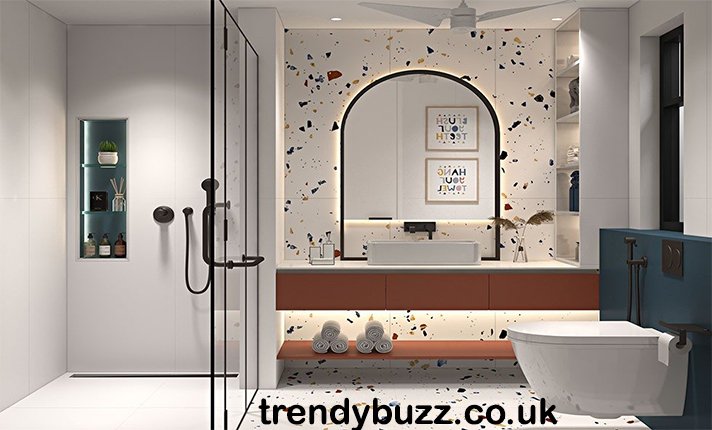Introduction
A bathroom should be more than a place for quick showers and rushed mornings. With a few smart design choices it can become a relaxing, efficient and stylish sanctuary. Whether you have a tiny powder room or a roomy master bath, the ideas below mix current trends, practical storage strategies and eco-friendly upgrades so your space looks great and works smarter.
Warm, personal color palettes
Cool, clinical whites and grays are giving way to warmer, earthy hues. Think terracotta, forest green, soft ochre and creamy stone. These tones make a bathroom feel like a calm retreat rather than a sterile utility room. Pair warm paint or tile with wood-look vanities, rattan baskets and matte stone surfaces to add depth and tactile contrast. Softer shapes and layered textures help the space feel inviting and lived-in.
Making small spaces feel larger
If you’re working with a compact bathroom, clever layout choices and reflective surfaces are essential. A wall-mounted vanity or floating sink frees up floor space and visually enlarges the room. Large-format tiles or running the same flooring into a shower create a continuous plane that feels less fragmented. Frameless glass shower screens and full-height mirrors remove visual barriers and let light pass through the space, making it feel more expansive.
Smart storage that looks good
Storage is the unsung hero of bathroom design. Built-in niches in showers, recessed medicine cabinets and tall, slim linen cupboards maximize useful space without crowding the room. For renters or anyone avoiding permanent fixes, modern suction-cup organizers, adhesive shelves and modular shelving provide stylish, repositionable options. Keep countertops clear with trays and shallow drawers so the room reads as tidy and calm.
Spa-inspired details for everyday calm
Borrowing cues from spa design can transform daily routines. Install a rain-style or high-efficiency shower head for a more luxurious feel, add a teak stool or bench for warmth, and layer towels to create a tactile, comforting atmosphere. Prioritize layered lighting — bright task lights for grooming, softer overhead lights for relaxation and accent lighting for mood — so the room adapts to different needs.
Sustainable fixtures that save water and money
Sustainability is now a crucial part of thoughtful bathroom design. Low-flow showerheads, faucet aerators and dual-flush toilets reduce water use while maintaining performance. Upgrading fixtures can lower bills, and many jurisdictions offer rebates for efficient appliances. Choosing high-efficiency plumbing and LED lighting is both eco-conscious and financially sound, helping the bathroom feel modern and responsible.
Texture and pattern for tactile interest
Texture adds personality without overwhelming a space. Fluted glass, ribbed tiles, terrazzo and mixed-material vanities create subtle drama and tactile appeal. Use patterned floor tiles to anchor a powder room or select a single textured accent wall in a larger bath. Balance one or two strong textures with smooth surfaces so the overall effect feels curated, not chaotic.
Lighting and mirrors that amplify space
Mirrors and lighting are two of the most transformative elements in a bathroom. A wide mirror above the vanity reflects light and increases depth, while mirrored medicine cabinets combine storage and reflection. Layer ambient, task and accent lighting and include dimmable options so the space can switch from bright and energetic to warm and restful instantly. Small LED strips under floating vanities or along shelves add polish without a major expense.
Budget-friendly updates with big impact
You don’t need a full renovation to refresh a bathroom. Simple swaps — new hardware, a fresh coatof paint on a vanity, regrouting tile or a new faucet — can make a dramatic visual difference. Peel-and-stick tiles and adhesive backsplashes are renter-friendly ways to experiment with trends. Even modest sustainable swaps such as low-flow fixtures usually pay back through lower water use and improved efficiency.
Safety, accessibility and longevity
Design for the long term by choosing slip-resistant flooring, installing strategically placed grab bars that match your finishes, and selecting comfort-height toilets and lever-style handles for ease of use. Durable, low-maintenance materials in wet zones reduce future repair needs and help the bathroom age gracefully. Designing for accessibility now increases comfort for all ages and protects home value.
Practical shopping and maintenance tips
When shopping, prioritize finish samples and physical swatches — lighting and grout change how color reads in a real bathroom. Buy fixtures with good warranties, and choose ceramic or porcelain tiles for their durability in wet spaces. Maintain your fixtures by replacing aerators yearly and descaling showerheads to keep performance high. Small investments in maintenance preserve both function and style.
A simple design checklist
• Decide your primary goal: comfort, storage, sustainability or style.
• Select a dominant material and one contrasting accent (for example, wood + stone).
• Maximize vertical storage and use recessed solutions where possible.
• Layer lighting and include a large mirror to open the room visually.
• Choose two smart upgrades: a high-efficiency showerhead and a dual-flush toilet.
• Add a tactile element like fluted glass or a woven basket for warmth.
Inspiration sources and planning
Collect photos and samples before you commit. Create a small mood board with paint chips, tile samples and hardware finishes to ensure harmony. Browse magazines, social feeds and local showrooms to note elements you like — specifically lighting types, storage solutions and tile patterns. Measure carefully and sketch a simple plan with dimensions; tiny changes in plumbing or door swing can have outsized effects on functionality and cost. When hiring tradespeople, request itemized quotes, keep clear communication and choose trusted local trades today. Start with small, reversible changes and expand as your budget and confidence grow steadily.
Conclusion
With balanced color, layered texture, intelligent storage and efficient fixtures, any bathroom can become a personal sanctuary. Use these ideas as a starting point, visit showrooms or online galleries to see finishes in person, and pick the options that match your budget and lifestyle. Small thoughtful changes often deliver the biggest improvements, turning a routine room into a restful retreat
